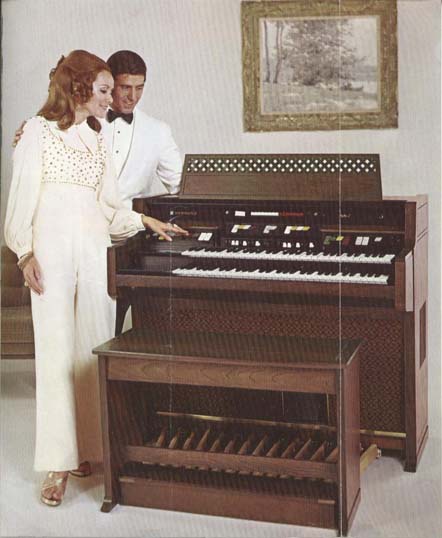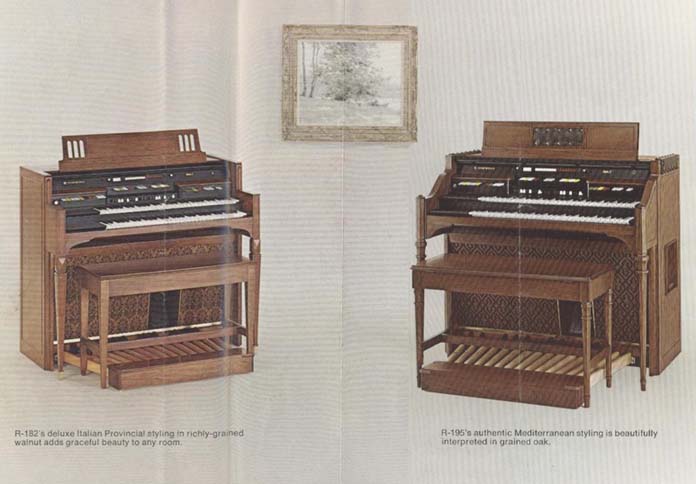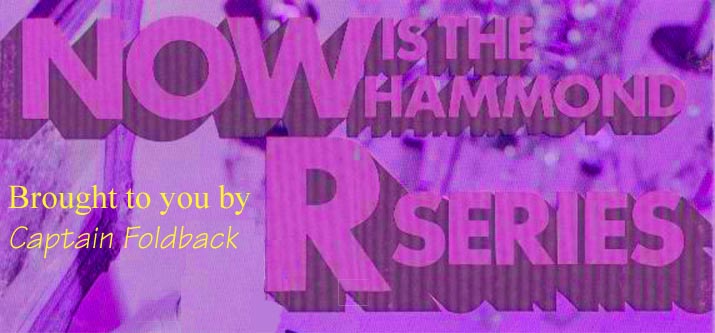
Acknowledgements: Very special thanks to Reinier de Groot, Steve Blair and Les Lacy for their contributions to this page
The Last Of The Greats
The R-100 series Hammond could be called 'the
last of the greats' in the sense that it was the very last tonewheel console
to be introduced. That was in 1970. By the time it was Hammond's most full
featured organ for the home market with such goodies as a built-in Leslie
unit, pedal sustain and the Hammond Rhythm II drum machine. This organ is as
far as you can get from the traditional B-3 style and still call it a
Hammond tonewheel console. This is said to indicate that it is hard to
compare the R-100 series with the B-3.
So what is it?
In concept, the R-100 takes over where the E-100 left: A relatively simple
home organ with controls and features like an overgrown spinet. One set of
nine drawbars per manual, two full manuals and a full 25note pedalboard, few
presets (controlled by tabs), built-in reverb and a multi-voiced percussion
section with adjustable reiteration.
Technically speaking
The R-100 is all solid-state, no tubes at all. Of course, the jaw-dropping
feature of this particular organ was the built-in Leslie and it was even the
brand new Roto-Sonic version as found in Leslie cabinets model 710 and 610.
Something was missing, though: The Hammond vibrato. With the inclusion of
the Leslie unit in the console, Hammond found it unnecessary to include the
vibrato scanner and delay line (which would have made the organ more
expensive too).
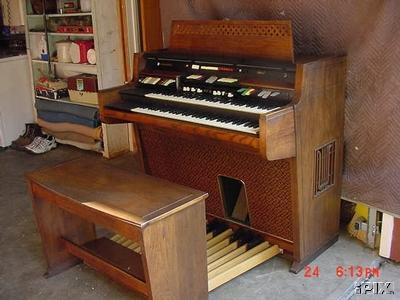
Steve's R-124 resting peacefully in his garage
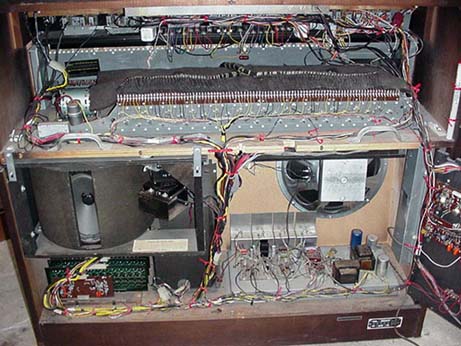
Channel surfing
On the left, a picture of Steve's R-124 seen from the back. The Roto-Sonic
Leslie unit with the 6x9 speaker is clearly visible. The organ power
amplifier is dual channel - one channel for the Main (stationary) and one
for the Leslie. The main channel has a 15" bass speaker and an 8" (not
visible) for the mids and highs.
The two-channel amplifier system provided
for a flexible variety of sounds as most of the organ's sound sources could
be routed to either channel or both. The deepest bass tones were always
routed to the stationary channel regardless of the tab settings, simply
because the Roto-Sonic speaker is not suited for frequencies below, say,
250Hz.
There is no separate reverb channel in the R-100, as opposed to earlier
organs like E-100 or A-100. Instead, the reverb signal can be routed to
either of the two output channels. The table below shows the various
combinations of sounds and output channels
| Source | Route to Main | Route to Leslie |
| Upper manual | Yes | Yes |
| Lower manual+pedals | Yes | Yes |
| Percussion | Yes | Yes |
| Brush/cymbal | Yes | No |
| Rhythm II | Yes | No |
| Reverb | Yes | Yes |
When the 'Leslie Chorus' tab is depressed, the Main channel will always be on and the Leslie selectors will switch between Main+Leslie and Main Only.
Here are the groups of tabs that control the Leslie and Reverb. The R-100 used the 'color-matic' style of colouring the tabs depending on their function. While it may aid the organist in distinguishing the different tabs, the estethics are at best questionable (in my humble opinion :) ). The placement of the Leslie Fast tab is also a bit of a concern - but then again, this organ is not made for rock'n roll.
Connections
R-100 organs came with a tone cabinet socket for the Hammond
Series 10 cabinet which was able
to reproduce both channels but with no amimation of course. The recommended
Leslie model to be paired with this organ was model 610 - a dual Roto-Sonic
cabinet with three channels and four amplifiers (tube) using Leslie kit #
8050.
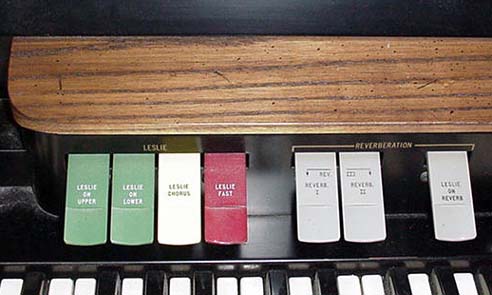
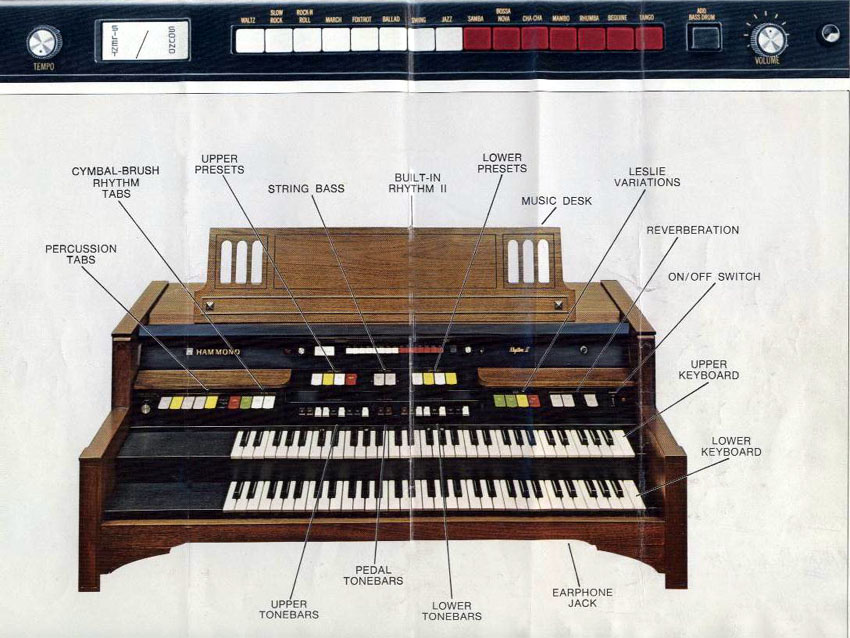
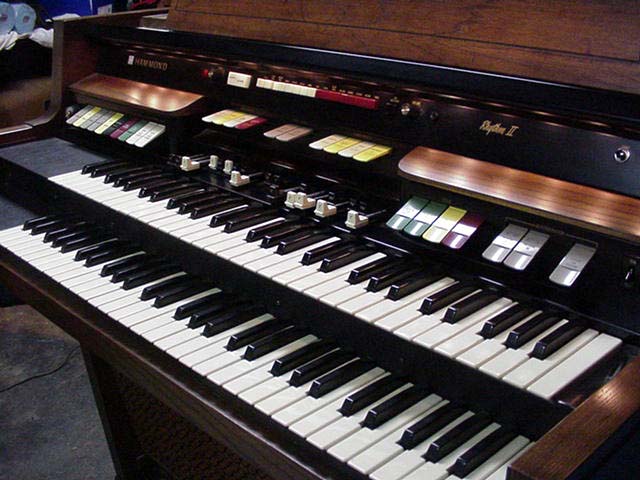
The manuals up close - color-matic colours all over!
Like all other Hammond organs, the R-100 came in different cabinet stylings or finishes. The R-124 'contemporary' on the right sure has these people smiling. Below are shown two other versions - the R-182 Provincial Italian and R-195 Mediterranean.
